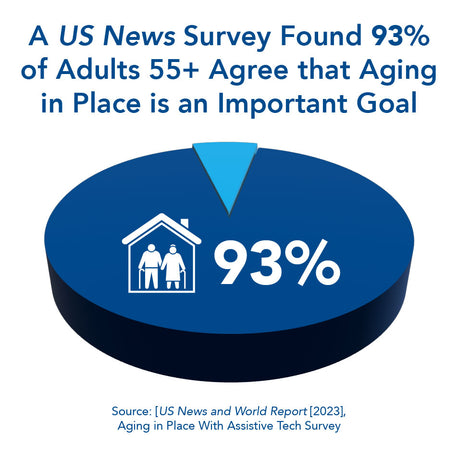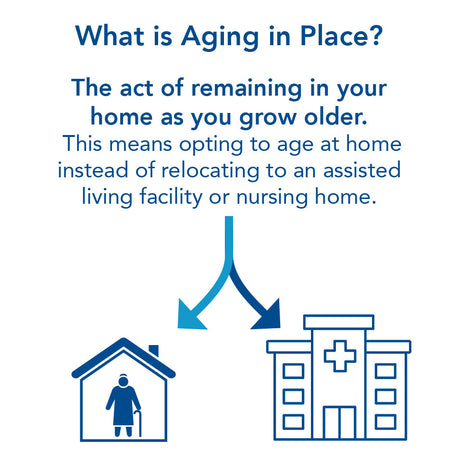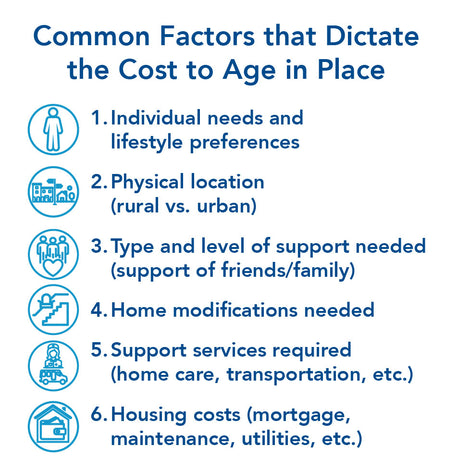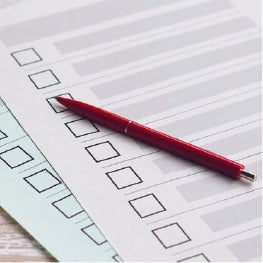
The 2024 Ultimate Guide to Aging in Place
Everything you need to know about aging in place.
Author:START READING
A special thank you to these contributing aging in place professionals:

Margot C. Ware RN BScN GNC(C)
President of Shylo Home Health Care

ComForCare Home Care
In-Home Care Providers
Related Articles
- The Ultimate Guide to Aging in Place
- Aging in Place Statistics
- The Ultimate Aging in Place Checklist
- The Pros and Cons of Aging in Place
- Aging in Place Bathroom Design Ideas
- Aging in Place Kitchen Design
- The Most Common Aging in Place Mistakes and How to Avoid Them
- Tips to Make Aging Gracefully More Manageable
Are you one of the 93% of adults aged 55+ who believe that aging in place is essential for a happy and healthy life?
If so, you're in the right place! We understand that aging in place is a cherished goal, but achieving it requires careful planning, patience, and a bit of know-how.
We interviewed aging in place experts to create this comprehensive guide to help you navigate the ins and outs of aging in place. From the reasons why it's such a popular choice to its associated costs, we've got you covered.
By the end of this article, you'll have all the tools you need to successfully age in place and enjoy your golden years. So, let's get started!

What is Aging in Place?
As we grow older, our mental and physical abilities begin to weaken. Our cognitive functioning depletes, we move slower, and our ability to perform physical activities weakens. Because of this, we're forced to make changes to keep our quality of life. One of those changes involves deciding where to live as we age.
There are typically two options:
- Move to some form of assisted living (this can be a family member's home or a nursing home)
- Remain in our house, known as aging in place
Aging in place tends to be the most popular choice, but what does aging in place mean? It's the act of remaining in your home as you grow older. This means opting to age at home instead of relocating to an assisted living facility or nursing home.

As simple as the aging in place definition may sound, it's a journey requiring important decisions, sacrifices, and preparation. When people decide to stay in their homes, they often modify their living space and add extra services to make their daily lives manageable.
It's important to know that every situation is different. While the definition is universal, the steps needed to age at home vary depending on:
- Physical health
- Financial status
- Home size/type
- And available resources.
Why Do Seniors Want to Stay in Their Homes?
Both options (remaining at home or moving to assisted living) have pros and cons. However, it's clear that aging in place is the popular choice. The experts at ComForCare Home Care, who specialize in helping seniors age in place, report these common reasons:

They Want to Preserve Their Independence
Independence is an essential aspect of being a happy human. "Staying at home allows seniors to maintain a sense of independence in daily activities," says the experts at ComForCare Home Care. Living at home allows seniors the freedom to set their own schedules, choose meals, and manage their belongings.
On the contrary, moving to assisted living may cause seniors to feel as if they're losing independence and identity.
Home is Comfortable & Familiar
From the Expert:
"Many seniors have emotional attachments to their homes, filled with cherished memories."
- ComforCare Home Care
A house is much more than a dwelling space. It represents a lifetime of memories, familiar surroundings, and one's ultimate comfort zone. A person's home holds decades of experience, personal items with sentimental value, and routines that provide stability and security.
Taking away a senior's home can be stressful. It removes their comfort zone and creates stress from the moving process.
They Want to Keep Their Community Connections
Humans are social creatures. The longer we stay in a specific home, the more we develop bonds and relationships with the surrounding community. We create a support system integral to our well-being and sense of belonging.
Chances are that seniors have developed a network of neighbors, friends, and family members that they prefer not to give up.
From the expert:
"Familiarity provides comfort and a sense of belonging to a community. Some seniors may have specific reasons to stay in their neighborhood. Perhaps they want to stay within walking distance of their golf club, to have grandchildren be able to stop in on their way home from school, or to continue walking their favorite path with their dog."
- Margot C. Ware RN BScN GNC(C), President of Shylo Home Healthcare
Moving to assisted living can jeopardize that support system.
It's Often More Affordable than Assisted Living
From the expert:
"This financial advantage is a compelling reason for seniors to remain in their own homes, even when they need some care support."
- Margot C. Ware RN BScN GNC(C), President of Shylo Home Healthcare
Affordability is one of the biggest reasons older people want to stay in their homes. Moving from home to assisted living or a nursing home can be costly. A 2023 report found that the average monthly cost of assistive living facilities ranges from $3,000 to $9,000. The report found the average nursing home cost is $5,000 to $13,000+ per month.
From the expert:
"Independent Living and Assisted Living residences are often built to offer a luxury experience, and their prices reflect that"
- Margot C. Ware RN BScN GNC(C), President of Shylo Home Healthcare
This also doesn't consider the cost of moving, transportation, and the loss of home equity. It's also common for seniors to have a lower mortgage accompanied by lower living costs.
How Much Does Aging in Place Cost?
One of the biggest concerns when aging in place is the costs associated. The truth is, it will vary on the scenario.
Every situation is different. The total cost will depend on factors such as overall health, physical abilities, and available resources. Below, we list common factors that will depend on the price for you to age in place:
- Individual needs and preferences: This goes beyond physical and personal care needs. It also includes lifestyle preferences such as how often you buy a car, luxury purchases, eating out, etc.
- Physical location: Your local cost of living will dictate your total cost. For example, living in urban than rural areas is often more expensive.
- Type and level of support needed: This all comes down to the resources you'll need and what's available. For example, if you need someone to drive you, you may have a friend/family member who can do it at no cost. Additional help may need to be hired if this isn't an option.
- Home modifications needed: Home modifications are often pivotal to home aging. However, the cost can vary significantly. For example, simple items such as grab bars and raised toilet seats are cost-effective. Significant changes, such as adding a wheelchair ramp or installing a new shower stall, can be more expensive.
- Support services needed: Many services can make aging at home a viable option. These vary but include home care, grocery delivery, adult day care, occupational therapy, and transportation services.
- Housing: The house cost will vary significantly and is something to consider heavily. This includes the cost of mortgage/rent, maintenance, utilities, HOA fees, and more.

How to Age In Place
To age in place, you must make it physically, mentally, and financially possible. Below, we highlight five actionable pieces of advice to make this process as easy and efficient as possible.

Prepare As Soon As Possible
From the expert:
"Prepare today to enjoy tomorrow."
- Margot C. Ware RN BScN GNC(C), President of Shylo Home Healthcare
The sooner you start preparing, the better. This goal takes time but can take years of preparation to make possible. Here are a few key areas to consider when preparing:
- Your ideal living situation: What do you want your living situation to look like? Do you want to live close to family/friends? Can you and do you keep up with the maintenance of your current house?
- Your health requirements: Do you have any health conditions that require special care? Will they require special care in the future? Will you be able to remain independent? If not, what resources will you need?
From the expert:
"You will want to try and foresee what your needs will be in six months and six years, and prepare today."
- Margot C. Ware RN BScN GNC(C), President of Shylo Home Healthcare

Know How Much it Will Cost
It is vital to clearly understand how much it will cost to age in place. This means having a long-term budget that considers your income and expenses. You'll need to calculate how much you'll need for home care services, modifications, and monthly living expenses.

Stay on Top of Your Physical Health
Your health may be the most significant factor determining whether aging in place is viable. For this reason, you must regularly visit your doctor and seek treatment for any existing conditions.
Knowing the physical aging process and what it brings is also essential. As we age, our bodies lose strength and balance abilities. These effects put us at greater risk of falling and injury.
Taking preemptive action through strength-building and fall-prevention exercises can help you keep your physical ability and independence.

Remain Socially Engaged
One of the advantages of moving to assisted living is the social engagement that comes with being around others. However, aging in place creates isolation, which can cause loneliness and depression.
Because of this risk, you must incorporate social activities into your weekly routines. This can be through joining programs, clubs, religious communities, or local events. You can also use technology through online courses, video chat, and social media.
Make Needed Home Modifications
Making proper home modifications is vital for a few reasons:
- Safety: As we age, we become more prone to falls and injury. Adding grab bars, better lighting, and non-slip flooring increases safety and reduces fall risk.
- Enhanced mobility and independence: Decreased mobility is a common effect of aging. To maintain independence, incorporate stair lifts, wheelchairs, walkers, and adjustable furniture. These can allow you to move around without relying on another person.
- Improved quality of life and comfort: Smart home technology, emergency call systems, and step-free showers can make daily living easier. The added comfort makes a significant difference in quality of life.
The experts at ComforCare Home Care also recommend condition-specific modifications. Conditions like Arthritis may require handrails and lever-style door handles to ease mobility challenges. Those with Dementia/Alzheimer's may need secure locks and labeling to aid in navigation.
Regardless of the condition, it's vital to incorporate adequate home changes to make up for any loss of accessibility.
To prepare to age at home, it is recommended to do a home walk-through. This will help you identify any safety and accessibility issues. We recommend reading our guide to in-home safety, which offers 79 tips for senior safety. It's also worth hiring a certified aging in place specialist who can make recommendations.
Aging in Place Resources
We're fortunate to live in an age where information on aging in place is abundant. This makes this process much easier as you can easily find the right services, organizations, and communities. Below, are typical aging in place services and resources you can use to ensure you age comfortably.

Friends and Family
One of the most helpful resources to gather is your friends and family. Because of familiarity, your friends and family can be your greatest asset in aging in place. Be sure to confide in them for support you may need. This can be in transportation, grocery, housework, and more.
Friends and family can be a tremendous mental, physical, and emotional support system when aging at home. So be sure to gather them early to have that support in place.

Government Resources
Many government resources can help with the process of aging in place. Many are based by state, county, and city to assist locally.
- Area Agencies on Aging (AAA): Every state has a network of AAAs that act as one-stop shops for information and assistance on aging issues. Find your local AAA here: https://www.usaging.org/
- State and local government websites: Most state and local government websites have dedicated sections on aging resources. These often include programs for in-home care, transportation, meals, and more.
- Benefits.gov: This federal website provides a comprehensive overview of government benefits available to older adults, including Social Security, Medicare, and Medicaid. Check it out here: https://www.benefits.gov/
- Eldercare Locator: This national database helps you find local eldercare services such as adult day care and home care agencies. Explore it here: https://eldercare.acl.gov/

Home Care Services
Aging in place home care is one of the most common services for those staying home. Margot Ware, president of Shylo Home Healthcare, says, "home Care includes most services a senior will ever need to stay in their home and age in place and is simply charged by the hour, or by the day." Some of these services include:
- Personal care such as bathing, dressing, and other activities of daily living
- Homemaking, such as housekeeping, laundry, and meal preparation
- Transportation to medical appointments, social outings, and errands
- Companionship for social interaction and emotional support
- Medication management
- Skilled nursing care for complex needs such as wound care and injections
- Technology assistance for help setting up devices such as medical alters systems and communication tools.
A home care professional may provide an extensive list of services or only a few, depending on the person's needs. You may also turn to organizations that offer specific services such as housekeeping and laundry.

Adult Daycare
Adult daycare can be an excellent aging in place solution for social interaction or daytime care. Adult daycare services vary but typically include personal care assistance, health monitoring, transportation, meals and snacks, and various social and recreational activities.
The National Adult Day Services Association has a great tool to help you find a center: https://www.nadsa.org/locator/

Transportation
Transportation is a crucial subject to cover when looking to age in place. The AAA Foundation for Traffic Safety reports that 78 is the average age people stop driving. More importantly, the CDC found that the rate of drivers 65 and older involved in fatal crashes per mile driven is more than twice the rate of drivers ages 35-44.
Old age can make driving hard. This can be from a mix of vision loss, hearing impairment, reduced mobility, and cognitive decline. Luckily, there are many transportation services available for seniors, including:
- Public transportation such as buses, trains, subways, and taxis
- Ride-sharing apps such as Uber and Lyft
- Senior-specific programs such as paratransit, senior shuttles, community vans, and dial-a-ride services
Having a transportation plan is vital to ensure you can get around. Consider cost, availability, accessibility, and other personal preferences when making transportation decisions.

Aging in Place Organizations
There are specific organizations whose mission is to help seniors wanting to age in place. These companies offer a variety of help, including research, finances, nutrition, and more.
- National Council on Aging (NCOA): A leading national organization serving seniors through research, advocacy, and practical programs. They offer resources on caregiving, health, benefits, and housing. Visit their website here: https://www.ncoa.org/
- AARP: A non-profit membership organization for people 50+. They offer resources on health, finances, travel, and advocacy. Visit their website here: https://www.aarp.org/
- National Center for Assisted Living (NCAL): A non-profit organization advocating for high-quality assisted living communities. They offer resources for residents, families, and professionals. Visit their website here: https://www.ahcancal.org/
- Meals on Wheels: Delivers nutritious meals to homebound seniors. Find your local Meals on Wheels program here: https://www.mealsonwheelsamerica.org/
- Village to Village Network: These local membership organizations help seniors stay independent via social support and practical assistance. Find your local village here: https://www.vtvnetwork.org/
This list is just a tiny portion of the abundant organizations available. Check locally for organizations dedicated to empowering seniors to age in place.
Frequently Asked Questions
Is is Possile to Age in Place?
Yes! It's very possible to age in place. A 2018 study by AARP found that 76% of adults 65 and older live in their own homes. Factors that contribute to successful aging in place include:
- Good physical and mental health
- Strong social connections
- Accessible housing and transportation
- Financial Security
- And access to support services.
What are the Basics of Aging in Place?
The basics of aging in place include:
- Deciding if your home is the best housing option to meet your needs
- Creating a long-term plan to set yourself up to age in place comfortably
- Saving money for future expenses
- Gathering the needed resources (friends, family, home care services, etc.)
- Making home modifications to meet physical needs (i.e., installing a ramp, adding bath safety items, etc.)
- And engaging in social activities to maintain good mental health and prevent social isolation
Conclusion
Aging in place can be one of the most rewarding aspects of old age. It offers a source of independence, comfort, and empowerment that alternative housing options don't. However, it requires determination, patience, and perseverance to do successfully. With proper steps, resources, and planning, it's possible.
What are some ways you're making aging in place easier? We'd love to hear them! Leave a comment below.
Aging in Place Resources
About the Author

Brandon Landgraf is the Digital Marketing Manager for Carex Health Brands. He finds passion and fulfillment in creating content that enhances, improves, and enlivens others' quality of life. All of his written work is formulated to not only offer essential advice and tips but back it with proven studies and experts. His mission is to connect with readers and provide steps to make their lives better.
You can connect with him on LinkedIn here.
About Carex Health Brands
Carex is your one-stop shop for home medical equipment and for products that assist caregivers with providing the best possible support and care for their loved ones. Carex Health Brands has been the branded leader in in-home, self-care medical products for over 35 years. Our goal is to improve the lives of our customers by bring them quality products that bring dignity back to their lives. With our three nationally distributed brands, Carex Health Brands serves national, regional and independent food, drug and mass retailers along with wholesalers, distributors and medical dealers.


